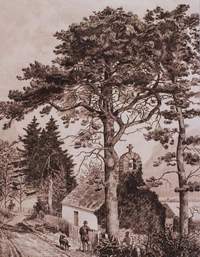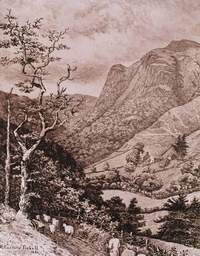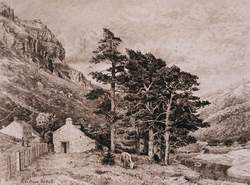Abandoned Communities ..... Reservoirs of Wales
The other highly recommended source of information about the Elan Valley scheme is the book "The Vale of Nantgwilt: A Submerged Valley". This book was produced in 1894 by one of the engineers on the project, Eustace Tickell. It includes several excellent etchings drawn by Tickell himself.
Eustace Tickell himself wrote the Preface to the book. He acknowledged that several buildings would have to be demolished, including about twenty farmsteads, and expressed some sadness at this prospect. He stated the only possible justification for this action, namely that "it would be difficult to find in this island a place where more than 70 square miles of land could be taken for a public purpose without dispossessing very many more people, and destroying many more homes." He asserts that the Elan Valley "is visited by few, there being no inn for the tourist to put up at. But those who have known it will never forget the charm of the scenery, and the genial hospitality of the inhabitants, from the lord of the manor to the poorest shepherd on the hills."
After the Preface there is a chapter headed "The Birmingham Water Scheme" by James Mansergh, the consultant engineer to the project. Read it if you want to be gripped by the excitement that Mansergh and his colleagues must have felt as the scheme progressed. Buried in the chapter, however, is a brief reference to the opposition that was expected at the start of the project. The rights of the local people are passed over very quickly, but Mansergh realised that more effective opposition might come from Mr Robert Lewis Lloyd, the owner of Nantgwyllt. Mansergh noted that "the Committee in charge of the Bill very prudently came to terms with that gentleman early in the proceedings."
The longest chapter in the book is "Shelley at Cwm Elan and Nantgwilt", by William Rossetti. The chapter includes extensive quotations from letters to and from the poet Shelley during his stays in the Elan and Claerwen valleys in 1811 and 1812. In 1811 Shelley, aged 18, stayed at Cwm Elan, the other of the two large houses. He was invited to stay there by the owner, Mr Thomas Groves, in spite of the fact that his engagement with Thomas Groves' sister, Harriet, had recently been broken off. The other major event in Shelley's life earlier that year was his expulsion from Oxford University.
While staying at Cwm Elan Shelley was in contact with another Harriet, Harriet Westbrook, then aged 16. Harriet Westbrook would not co-operate with her father's plan to send her back to school, and according to Shelley she pleaded with him to allow her to "fly" with him. Shelley returned to London, met Harriet, and they eloped to Scotland and married in Edinburgh.
In April 1812, after travels that included Dublin and North Wales, the couple decided to come back to the Claerwen valley and stay at Nantgwyllt. They soon became so attached to the place that they entered into negotiations to buy the lease on the house. In the end, however, the deal fell through. Shelley and his wife were obliged to leave the house, and they went back to stay again with Thomas Groves at Cwm Elan.
During this time Shelley wrote a poem entitled "The Retrospect", parts of which are reproduced in the section on Poetry.
The relationship between Shelley and Harriet did not have a happy ending. Within two years they had separated, and in 1816 Harriet committed suicide by drowning in the Serpentine. Shelley too died by drowning, off the coast of Italy in 1822. To quote William Rossetti, "And now a watery doom effaces the scenes of their short-lived love, Nantgwilt and Cwm Elan. A world of waters, a world of death."
As at Lake Vyrnwy the water level in the reservoirs falls during periods of exceptional drought and the remains of buildings and walls may be exposed.
Eustace Tickell himself wrote the Preface to the book. He acknowledged that several buildings would have to be demolished, including about twenty farmsteads, and expressed some sadness at this prospect. He stated the only possible justification for this action, namely that "it would be difficult to find in this island a place where more than 70 square miles of land could be taken for a public purpose without dispossessing very many more people, and destroying many more homes." He asserts that the Elan Valley "is visited by few, there being no inn for the tourist to put up at. But those who have known it will never forget the charm of the scenery, and the genial hospitality of the inhabitants, from the lord of the manor to the poorest shepherd on the hills."
After the Preface there is a chapter headed "The Birmingham Water Scheme" by James Mansergh, the consultant engineer to the project. Read it if you want to be gripped by the excitement that Mansergh and his colleagues must have felt as the scheme progressed. Buried in the chapter, however, is a brief reference to the opposition that was expected at the start of the project. The rights of the local people are passed over very quickly, but Mansergh realised that more effective opposition might come from Mr Robert Lewis Lloyd, the owner of Nantgwyllt. Mansergh noted that "the Committee in charge of the Bill very prudently came to terms with that gentleman early in the proceedings."
The longest chapter in the book is "Shelley at Cwm Elan and Nantgwilt", by William Rossetti. The chapter includes extensive quotations from letters to and from the poet Shelley during his stays in the Elan and Claerwen valleys in 1811 and 1812. In 1811 Shelley, aged 18, stayed at Cwm Elan, the other of the two large houses. He was invited to stay there by the owner, Mr Thomas Groves, in spite of the fact that his engagement with Thomas Groves' sister, Harriet, had recently been broken off. The other major event in Shelley's life earlier that year was his expulsion from Oxford University.
While staying at Cwm Elan Shelley was in contact with another Harriet, Harriet Westbrook, then aged 16. Harriet Westbrook would not co-
In April 1812, after travels that included Dublin and North Wales, the couple decided to come back to the Claerwen valley and stay at Nantgwyllt. They soon became so attached to the place that they entered into negotiations to buy the lease on the house. In the end, however, the deal fell through. Shelley and his wife were obliged to leave the house, and they went back to stay again with Thomas Groves at Cwm Elan.
During this time Shelley wrote a poem entitled "The Retrospect", parts of which are reproduced in the section on Poetry.
The relationship between Shelley and Harriet did not have a happy ending. Within two years they had separated, and in 1816 Harriet committed suicide by drowning in the Serpentine. Shelley too died by drowning, off the coast of Italy in 1822. To quote William Rossetti, "And now a watery doom effaces the scenes of their short-
As at Lake Vyrnwy the water level in the reservoirs falls during periods of exceptional drought and the remains of buildings and walls may be exposed.
Four
Capel Nantgwilt
Tan-y-Foel
Dol Folau


